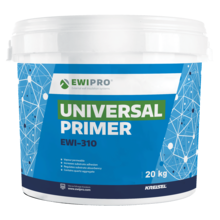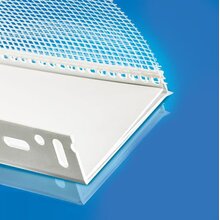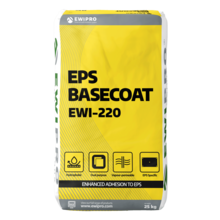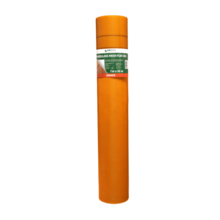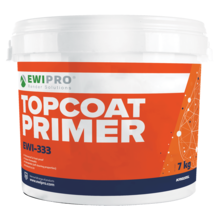
You might have heard about external wall insulation (EWI) through the likes of… well, us, or seen it in action whilst it’s being installed on your neighbours’ homes, but what you might not be so familiar with is how it’s installed. Here at EWI Store, we aspire to ensure that all our customers are fully informed about our EWI systems, including how they are installed in certain ways and why, and that what’s this blog is for. Here’s a simple step-by-step guide on how to install an EWI system.
Wall preparation
Before any work can begin, the external walls must be prepared. The preparation required varies depending on the condition of the building. In most cases, a simple scrub will do, but sometimes the existing external wall coating needs to be removed entirely. If you are installing EWI onto a smooth surface, then you will need to use our EWI-310 Universal Primer to allow the adhesive to stick to the walls. Alternatively, if the wall surface is uneven, the EWI-260 Levelling Mortar must be used to prepare the wall. To remove any organic growth, consider using a fungicidal wash.
Starter tracks application
Once the wall has been prepared, it is time to apply the starter tracks. The types of starter tracks to be applied depend on the EWI system being installed. The correct starter tracks should be applied to the walls above the DPC (damp-proof course). The starter tracks not only allow for the easy installation of insulation to the walls but also protect the surface of the insulation from weather, damp and other damage. The clip-on profile should be attached to aluminium starter tracks to create a neat finish between the starter track and the insulation.
Insulation application
After the starter tracks, the basecoat should be applied to the insulation using our modified dot-and-dab method (three dots in the middle and a layer all around the perimeter). For reference, the EWI-220 EPS Basecoat can be used as an adhesive. Use a notched trowel to spread the basecoat evenly across the back of the insulation board. The basecoat should be about 4-5mm thick. When placed on the wall, mechanical fixings should be used to enhance the security of the insulation (6 fixings per square metre of insulation). Allow 2-3 days for the basecoat to set before installing the mechanical fixings.
Beading and Verge Trims application
Before adding the basecoat, all beading must be applied. Beading is used to reinforce weak or impact-prone areas within the system, helping to prevent damage and reinforce structural integrity. Each beading has its own special function and area of application:
- Corner beads: Corner beads are embedded with mesh which sinks into the basecoat. Corner beads reinforce the external corners of the EWI or render-only system.
- Movement beads: Movement beads are used inside the corners of thermal insulation systems to create a permanent and weather-proof sealant of vertical movement joints.
- Bellcast beads: Bellcast beads are designed to provide a clean, natural stop to the render just above the DPC. The bellcast bead also propels water from the wall.
- Render movement beads: Render movement beads should be used where there is an expanse render area. The render movement bead should be applied vertically and is designed to prevent cracking within the render through thermal expansion and compression.
Basecoat and mesh layer application
After 2-3 days, another layer of the basecoat should be applied with a notched trowel over the top of the insulation boards at a thickness of 5-6mm. Then, fibreglass mesh is embedded into the basecoat in vertical strips using the flat edge of a notched trowel. Each vertical strip of fibreglass mesh should overlap its neighbouring vertical strip by approximately 10-15cm. At EWI Store, we recommend using fibreglass mesh because it increases the tensile strength of the system and goes an extra step further in preventing cracks and impact damage.
Render Primer application
Render primer is classed as an optional step, but to enhance durability and adhesion, we highly recommend applying a render primer to the basecoat. The render primer you use will depend on the render topcoat. For instance, if you're using our Silicone Silicate render, the Topcoat Render Primer is the most suitable. Alternatively, for our Acrylic render, the Mineral and Acrylic Primer is most ideal. This should be painted on and then left to dry for 12 hours; check out our blog all about our primer range for a deeper insight into render primer and its properties.
Render application
Once your final basecoat layer is dry, the final step is to apply the render. When we talk about render, we are referring to our thin-coat render range. The thickness of the render determines how thick the layer should be on the wall. For instance, if you select one of our Silicone Renders with a thickness of 1.5mm, the render should be applied no thicker than 1.5mm from the surface of the wall because, even though our renders are extremely flexible, durable and breathable, this can hinder the EWI system. At EWI Store, our range of advanced silicone renders can be tinted to absolutely any colour, catering to any taste and enhancing the external appearance of your property whilst also improving its thermal comfort. And, there you have it! Although this is a very basic installation guide that should be used merely for informative purposes, we hope you found this blog helpful in explaining the stages of installing an EWI system. Every installation is different so, if you have any further questions about installing EWI on your property, do not hesitate to call our technical team who are always happy to assist!

